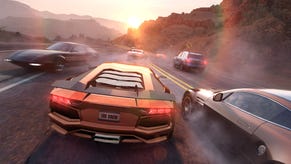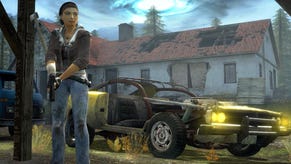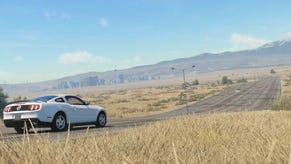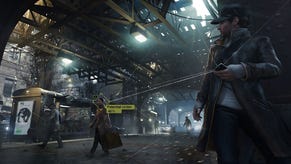Hands On: The Crew
2 Brendan 2 Caldwell
The Crew will see players zooming around a huge map of the United States and teaming up with friends for various feats of speed-freakery. We sent Brendan to take an early look at Ubisoft’s ‘MMO racer’.
The open-world racer was perfected on PC in 2009. I’ll let John and Jim argue over whether it was Burnout Paradise or Fuel that holds the honour. In terms of videogame history debates, I’m happy just to get the date right. Ubisoft, on the other hand, are not a company to let such claims rest. In a couple of months they are releasing The Crew, an MMO racing game with 6000 miles of reconstructed USA to zoom around. The titular Crew is, in keeping with an emerging Ubi-trend, you and three pals, each sitting pretty in your souped up Ford Mustang, Ferrari, Lamborghini or Other.
To get a small detail out of the way first, this is an MMO in a limited sense. There is an area around the players in which other online strangers can appear, described to us as a ‘bubble’. Up to seven other players can be driving within this bubble. So, theoretically (assuming you have a full compliment of friends) outside of the game’s many missions, races, or challenges, the world peaks at 11 racers at a time. It’s not massively multiplayer, it’s massive AND multiplayer. But honestly? It feels fine that way. The designers have not made The Crew to be a huge, persistent world capable of huge crowds. As funny as it would be to see an absurd 100-car pile-up on Route 66, a racing game would be infuriating, even impossible, with such crowded roads. The designers know that. “We’re not trying to create a congestion simulator,” says Creative Director, Julian Gerighty.
It is still massive in the traditional sense, however. The USA on show is a monster. You can bring up the map any time and use it to fast travel to any road you have previously unveiled. I did a quick highlights tour and managed to fit in the Salt Flats of Utah, Cape Canaveral in Florida, the Louisiana Bayou, the Navajo Trail, the Arizona Meteor Crater and Monument Valley. Each location looked good enough to want to buy a postcard. Putting aside the more structured portions of the game, The Crew is just goading you to put aside an entire day for a cross-country road trip.
On starting the game, however, the map of America will be obscured by a shroud that must be uncovered. (It would not be an Ubisoft game if you didn’t need to reach a high point and look around like a confused pigeon). Slowly unveiling the map of the US state-by-state is innately appealing to me. But you are also able to go from city to city by driving to an airport and sitting through a flight cinematic, dropping you across the country. Since you can’t fast travel to unexplored roads, it looks like this is the lazier way to get from one hub to another early on.
But an open world is nothing without stuff to do. There is a campaign of sorts, designed to take you on a narrative tour of the US. The storyline of this, by Gerighty’s own admission, is “not Shakespeare.” As far as I could tell, it is a bastardisation of whichever Fast and the Furious movie you hate the most. You are an undercover racer man, trying to infiltrate one of the country’s notorious vehicular gangs. It didn’t make much sense to me and the chatter between drivers during races had my eyes rolling so far back it made me feel nauseous. I think I saw my own brain stem.
Put that to one side. The missions themselves will give you a good taster of what’s out there on America’s open road. There are vanilla racing missions, time trials, inner-city ‘tailing’ missions and high speed pursuits. The best of the variants I played was a chase mission, in which all four members of your crew have to speed after a prisoner transport bus and bash it over. The bus has a health bar and the idea is to just keep hammering it until it runs out of health and crashes. Part of a team of four, we hounded this bus into the storm drains of Los Angeles but it wasn’t long before we picked up our own tail - the police. This was the game at its most arcadey and enjoyable. Other missions involved more measured races around circuit tracks, or long drives over isolated mountain roads. I am told there are also ‘epic’ non-story missions which take 4-6 hours to complete (WHAT). For instance, a long mission that challenges the player(s) to tour around the country taking in as many famous landmarks as they can.
On top of these, there are challenges spotted all over the country, hosted in blue circles where you can park to activate them. The game could live or die on the variety of these and the missions. One challenge involved staying on a thinning line for as long as possible, another (far out in the roasting Salt Flats) was just a straight drag race against a frighteningly fast ghost car. The idea here is that you won’t win until you get your own car up to spec. This is where some more MMO elements come in.
There are five ‘classes’ of car: Street, Dirt, Perf, Raid and Circuit (there’s also an average Joe classification that seems to be there just to get you started). Different car types are used for different events. So a Perf car needs to be used for a long, open freeway race with few turns, a Dirt car for races on rally-like tracks, and the Raid class for aggressive off-road pursuits. All cars in the game will ‘become’ the class you require when you start a race. For instance, your GT 500 is a Street car until you take it for a spin around the Bayou. At this point the game automagically changes the vehicle to its Dirt variant. So don’t worry, you won’t find yourself driving a finely tuned Circuit car through a wheat field. However, the designers stress that some cars should not stray too far from their design. “If you take a Lamborghini and took it off road,” says Gerighty, “it’s going to be against the fundamental philosophy of that company.” The suggestion is that some cars were just not built for some environments, and even though you could take your Volkswagon Golf on a high speed dash on the interstate, that doesn’t mean you should.
When you complete a race successfully, you’re rewarded with cash, experience points and a car part. All this allows you to buy more speedy things and upgrade your current speedy things, making them, by degrees, slightly speedier speedy things. The customisation options are extensive. I felt like I needed a mechanic, looking at the parts involved, so I kept my part in the car’s build limited to its looks. There are PLENTY of options here. Colours, tints, stickers, bumpers, tails, tyres, it’s all a hugely welcoming dress-up. You can even fiddle with the interior of your cars, just in case you don’t think the dim outline of your seats looks cool enough through the sheen of your rear windshield.
All right, reservations time. There’s a lot to like about The Crew, looking at the concept and the scale of the thing. But there are some worries. Like my forebearer Richard Stanton I found the handling of the cars themselves to be a bit … off. All the vehicles I tried felt too weighty, and precision braking was so often required that I sometimes felt no desire to use my nitrous boost at all, for fear of overshooting a turn. Drifting, likewise, resulted in a lot of spinning out.
There is a feature that supposedly helps you out when this happens. By holding down the B button on a gamepad for a second or two, your car will reappear on the road, close to where you came off. But this ‘back on track’ button is jarring. Did you ever screw up an early move in a tricky game like Tony Hawk’s Pro Skater, then immediately press Start then ‘Restart Session’, just to make sure you got the most out of your two minute run? That’s what it felt like I was doing every time I used the ‘back on track’ button in The Crew. It breaks the flow down a lot. Play becomes about remembering to hold the B button down whenever you start to get waylaid. Great arcade racers like the later Burnouts make crashes spectacular but they also make sure you immediately feel like you have the chance to catch up to the jerk who took you down. The distance between players closes incredibly fast. In The Crew you have a (totally invisible) health bar and weird, dumb things like this will occur. There’s rarely a dramatic crash and more than once my car ramped off rocky outcrops in a bizarre, spinning motion that I can only describe as an uncrash. So there’s no Burnout-like adrenal shock but the feeling of being left behind still makes you want to press your B button. Ubisoft have basically outsourced Lakitu’s job to your thumb, and it feels grimey.
With practice, of course, you may not need to resort to that device too frequently. And I certainly feel like more time with The Crew will lend a feeling of forgiveness to the somewhat wonky handling. The opportunity to do a 6-hour drive around the States, using the game as some sort of Kerouac Sim is undeniably inviting, even if Ubi’s formula (go to a high place, see some things, go do the things, do housekeeping tasks, go to another high place) started to become stale to me around the time of Assassin’s Creed Brotherhood. Likewise, the online elements are intriguing. I sadly didn’t get to see how the PvP stuff works on the larger scale but I would definitely be roused by the prospect of cruising around Chicago with friends, waiting to be slapped in the face by a virtual driving glove and challenged to a 4v4 face off.
There is a lot of things to like about The Crew so far. Your friends and the online features will probably make or break it for you. A lot of developers have realised that even a mediocre game can fool people into thinking it is great if you add three friends (hello, Destiny). My fear is that Ubisoft is exploring that ‘grab some buds’ marketing philosophy both with this game and Assassin’s Creed Unity. My hope is that they’ve got a racer that proves itself more than mediocre. We’ll have to see. My gut says if you can make it across America without wanting to abandon your Chevrolet in a canyon, then they’ll have succeeded.
The Crew is out on November 11.















